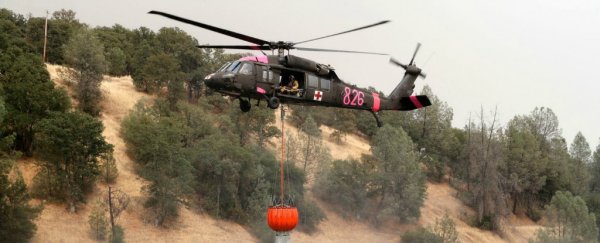Peter Gleick is a hydroclimatologist, co-founder of the nonprofit Pacific Institute and member of the U.S. National Academy of Sciences.
As if water and wildfire policies in the West weren't contentious enough, President Trump decided to toss confused and ill-conceived tweets into the mix over the past few days, reigniting fights over water and land use in California.
"California wildfires are being magnified & made so much worse by the bad environmental laws which aren't allowing massive amount of readily available water to be properly utilized," Trump said in a tweet Sunday.
He was back at it again Monday morning, decrying water that is "foolishly being diverted into the Pacific Ocean."
This is unmitigated nonsense and dangerous thinking, especially at a time when severe wildfires are sweeping over the state, more than 1,000 homes have been destroyed, the death toll is rising and more than 10,000 firefighters are risking their lives battling the flames.
There's no shortage of water to fight these fires. Indeed, water is one of the least useful tools for containing them. Firefighters build fire breaks, use chemical fire retardant to try to limit the spread and mostly work to protect infrastructure and lives by containing the extent of the fires.
As Daniel Berlant, assistant deputy director of California's fire agency, noted: "We have plenty of water to fight these wildfires."
Unsurprisingly, the president's comments completely ignore the role of human-caused climate change as a growing factor in the extreme fires that the nation is now experiencing.
Climate change is worsening long-term drought conditions, adding dry vegetation to fuel the fires and increasing the temperatures and extreme weather that accelerate their spread and intensity.
A century of forest fire suppression and inappropriate expansion of communities into high-risk fire areas have also contributed to the rising human and economic costs of wildland fires.
It is always difficult to know what this president knows and doesn't know, and what his intentions are when he makes false or confusing comments about current events. But part of his thinking here seems to have been to throw a bone to his California base.
Conservatives in the state would love to squeeze out even more water for California's irrigated agriculture by rolling back the few environmental protections in place to help endangered salmon, provide water for the few remaining wetlands that support critical bird migrations, and maintain water quality for coastal cities.
But there's little water to be had. The water that does reach the Pacific Ocean is only what's left over after the rest of it has been diverted to California's farms and cities.
The Colorado River is completely consumed by the United States and Mexico and disappears long before it reaches its delta. The San Joaquin River has been dried up for long stretches.
California's groundwater is so badly managed and over-pumped that lands in the Central Valley are sinking, damaging roads, buildings and, ironically, irrigation water canals. Any new diversion of water from the state's rivers will come out of someone else's supply.
There is another way forward. Farms and cities are taking steps toward more sustainable water policies every day. New technologies, including smart irrigation systems, monitor soil moisture and crop needs and provide the right amount of water at the right time, permitting farmers to grow more food with less water.
The efficiency of washing machines, dishwashers, toilets, faucets, shower heads and other residential and industrial water-using technologies is improving. Better water-pricing strategies are providing incentives to trade water among users and cut wasteful uses.
Homeowners are replacing grass lawns with drought-resistant gardens. Incremental steps are being taken to help protect and restore fisheries and natural ecosystems devastated by earlier uninformed water policies throughout the West.
And new unconventional sources of supply such as high-quality recycled water and stormwater are being tapped. The good news? Total water use in the West — and nationwide — is dropping, even as populations and our economies continue to grow.
New thinking about wildfire and forest management also has a crucial role to play in reducing the threat that extreme fires pose. Efforts are needed to thin undergrowth and reduce fuel loads in our forests.
Strategic tree-cutting can limit the spread and intensity of wildfires. And we must slow uncontrolled suburban development in high fire-risk areas.
Our fire and water challenges are worsened by climate change. Because the world has waited so long to respond to warnings from the scientific community, we must now work to cut the emissions of greenhouse gases that are driving worse — and accelerating — climate changes while we also tackle efforts to adapt to climate impacts we can no longer avoid.
Smart solutions to our water problems are out there. Smart solutions to the threat of California wildfires and the growing threat of climate change are out there. But they're not helped by ill-informed, politically divisive comments from the president.
2018 © The Washington Post
This article was originally published by The Washington Post.
Science AF is ScienceAlert's new editorial section where we explore society's most complex problems using science, sanity and humor.
